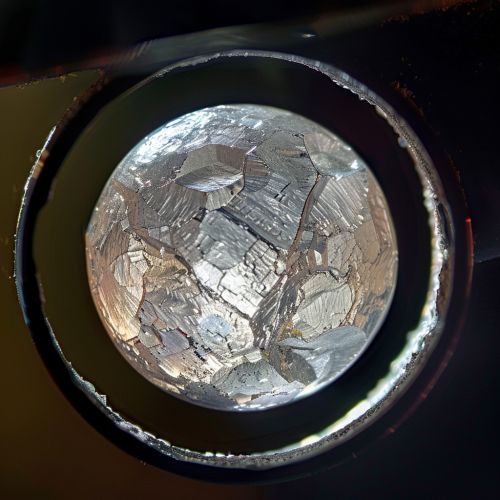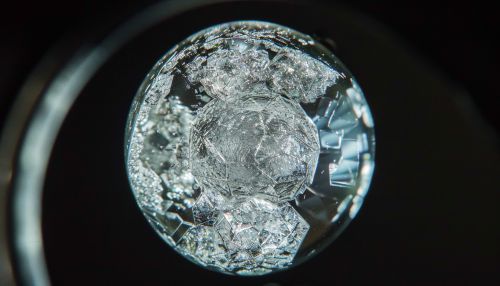Microtektite: Difference between revisions
(Created page with "== Introduction == Microtektites are small, glassy objects that are believed to be formed from terrestrial debris ejected during meteorite impacts. These objects are typically less than 1 millimeter in size and are a subset of tektites, which are larger glassy objects formed under similar conditions. Microtektites are found in deep-sea sediments and are of significant interest to geologists and planetary scientists due to their implications for understanding impact...") |
No edit summary |
||
| Line 7: | Line 7: | ||
Microtektites are formed during hypervelocity impacts when a meteorite strikes the Earth's surface. The immense energy from the impact melts and vaporizes the target rock, ejecting molten droplets into the atmosphere. These droplets cool and solidify as they fall back to Earth, forming microtektites. The composition of microtektites can vary depending on the type of rock that was melted during the impact, but they generally consist of silica-rich glass with minor amounts of other elements such as aluminum, iron, magnesium, and calcium. | Microtektites are formed during hypervelocity impacts when a meteorite strikes the Earth's surface. The immense energy from the impact melts and vaporizes the target rock, ejecting molten droplets into the atmosphere. These droplets cool and solidify as they fall back to Earth, forming microtektites. The composition of microtektites can vary depending on the type of rock that was melted during the impact, but they generally consist of silica-rich glass with minor amounts of other elements such as aluminum, iron, magnesium, and calcium. | ||
[[Image:Detail-91949.jpg|thumb|center|Close-up photograph of a microtektite under a microscope, showing its glassy texture and spherical shape.|class=only_on_mobile]] | |||
[[Image:Detail-91950.jpg|thumb|center|Close-up photograph of a microtektite under a microscope, showing its glassy texture and spherical shape.|class=only_on_desktop]] | |||
== Distribution and Discovery == | == Distribution and Discovery == | ||
Latest revision as of 22:01, 18 June 2024
Introduction
Microtektites are small, glassy objects that are believed to be formed from terrestrial debris ejected during meteorite impacts. These objects are typically less than 1 millimeter in size and are a subset of tektites, which are larger glassy objects formed under similar conditions. Microtektites are found in deep-sea sediments and are of significant interest to geologists and planetary scientists due to their implications for understanding impact events and the history of the Earth's surface.
Formation and Composition
Microtektites are formed during hypervelocity impacts when a meteorite strikes the Earth's surface. The immense energy from the impact melts and vaporizes the target rock, ejecting molten droplets into the atmosphere. These droplets cool and solidify as they fall back to Earth, forming microtektites. The composition of microtektites can vary depending on the type of rock that was melted during the impact, but they generally consist of silica-rich glass with minor amounts of other elements such as aluminum, iron, magnesium, and calcium.


Distribution and Discovery
Microtektites are predominantly found in deep-sea sediments, particularly in the Pacific and Indian Oceans. They are often discovered through the analysis of sediment cores extracted from the ocean floor. The first discovery of microtektites was made in the 1960s during the analysis of deep-sea cores, which revealed their presence in layers corresponding to known impact events.
Morphology and Classification
Microtektites exhibit a variety of shapes, including spherical, teardrop, and dumbbell forms. Their surfaces can be smooth or pitted, depending on the conditions under which they cooled and solidified. Microtektites are classified based on their size, shape, and chemical composition. They are typically divided into three main groups: normal microtektites, microkrystites (which contain crystalline inclusions), and microtektite fragments.
Geochemical Analysis
The geochemical analysis of microtektites involves the use of techniques such as XRF, SEM, and MS. These techniques allow scientists to determine the elemental and isotopic composition of microtektites, providing insights into the nature of the impact events that formed them. For example, the presence of certain isotopes can indicate the age of the microtektites and the type of meteorite that caused the impact.
Impact Events and Stratigraphy
Microtektites are valuable tools for studying the stratigraphy of sedimentary sequences. Their presence in a sediment layer can be used to correlate that layer with a specific impact event. This is particularly useful for dating sedimentary sequences and understanding the timing and frequency of impact events in Earth's history. Notable impact events associated with microtektite layers include the Chicxulub impact, which is linked to the mass extinction event that occurred 66 million years ago.
Paleoenvironmental Implications
The study of microtektites also provides information about the paleoenvironmental conditions at the time of their formation. For instance, the distribution and composition of microtektites can reveal details about the atmospheric and oceanic conditions following an impact event. This information is crucial for understanding the environmental consequences of large impacts, including their effects on climate and biota.
Technological Applications
While microtektites are primarily of scientific interest, they also have potential technological applications. Their unique properties, such as high silica content and resistance to chemical weathering, make them candidates for use in advanced materials and manufacturing processes. Research is ongoing to explore these potential applications and to develop methods for synthesizing microtektite-like materials in the laboratory.
